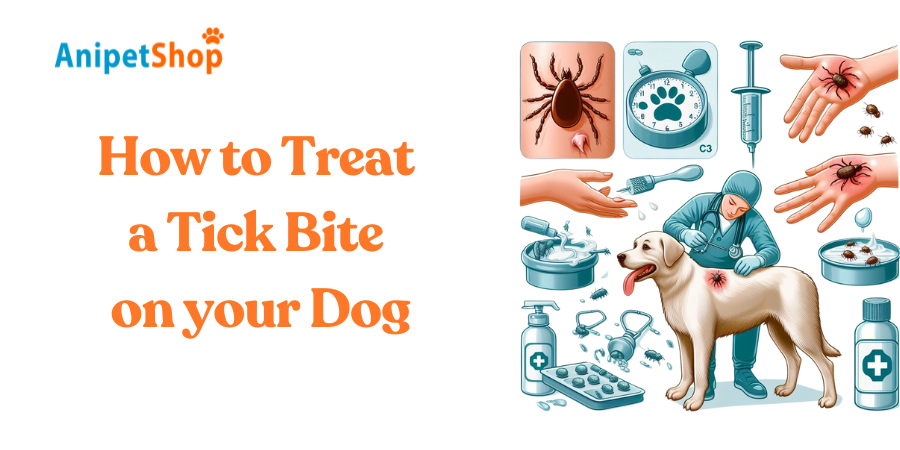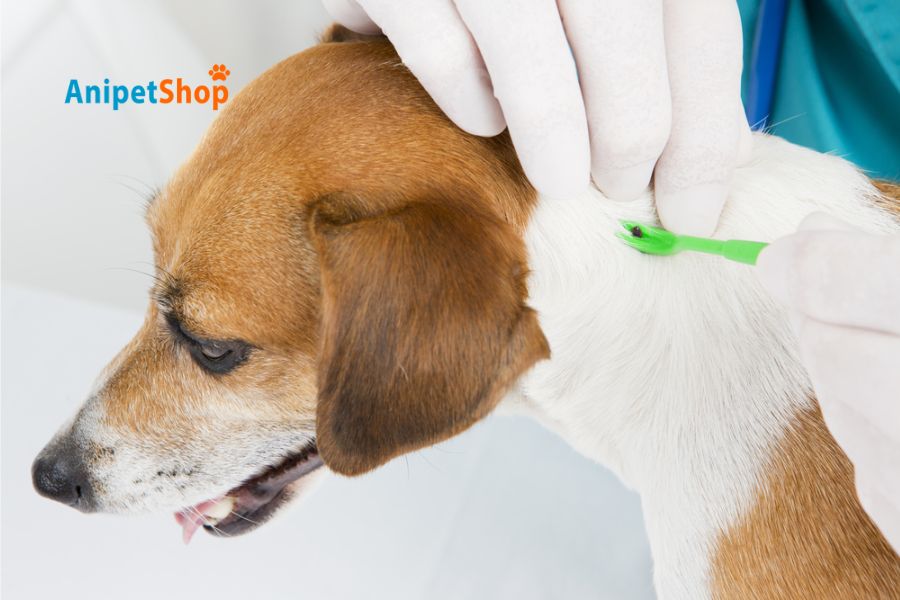How to Treat a Tick Bite On Your Dog
Ticks are a serious threat to your dog’s health, as they can transmit dangerous diseases like Lyme disease through their bites. That’s why regular tick checks should be a crucial part of your routine, especially if your dog spends time outdoors. In many regions, ticks remain active year-round, even after frost. To help you protect your dog, this guide covers everything you need to know about spotting and treating tick bites on your dog. Whether you’re looking for home treatment options or prevention tips, you’ll find it all here.
Key Takeaways:
- Safely Extract the Tick: Use fine-tipped tweezers or a tick removal tool to grasp the tick as close to your dog’s skin as possible and gently pull it straight upward. Avoid twisting, as this can leave parts of the tick embedded in the skin.
- Disinfect the Affected Area: After removing the tick, clean the bite area thoroughly with an antiseptic solution or rubbing alcohol to prevent infection and promote healing from the tick bite on your dog.
- Monitor for Infection Symptoms after a Tick Bite on a Dog: Consistently check the bite site for signs of infection such as redness, swelling, or unusual scratching. Prompt action can prevent complications.
- Apply a Cold Compress for Relief: Place a cold compress on the bite area to minimize swelling and alleviate discomfort. Consult your vet if your dog exhibits symptoms.

Step 1: Scan for Ticks
Begin by running your fingers slowly over your dog’s entire body to check for small bumps or swollen areas that might indicate a tick. These can sometimes feel like skin tags, so take your time.
Focus on the common areas where ticks are often found:
- Head, Chin, and Neck: Examine your dog’s head, chin, and neck. Ticks are drawn to these areas because of the easy access to blood vessels.
- Ears: Check inside and around the ears, paying attention to both the inner flap and outer areas.
After checking the common areas, inspect the rest of your dog’s body:
- Between Toes: Spread your dog’s toes to check between them, as ticks often hide in these secluded spots.
- Legs, Belly, and Armpits: Carefully examine the legs, belly, and armpits, as these warm, protected spots are favored by ticks.
- Tail and Anus: Don’t forget to inspect the base of the tail and around the anus, as ticks can also hide in these areas.
For a comprehensive guide on tick identification and removal, check out our article on ticks on dogs
Step 2: Remove Safely and Correctly
Promptly removing a tick from your dog lessens the risk of disease. Follow these steps for safe and proper removal:
What You’ll Need to Treat a Tick Bite on a Dog:
- Gloves
- Fine-tipped tweezers or a tick removal tool
- Disinfectant or antiseptic cream
- Isopropyl alcohol
Safety First: Always wear gloves while handling ticks to protect your skin from potential contact with harmful pathogens.
Using Tweezers:
- Grasp the tick as close to your dog’s skin as possible, ensuring you avoid pinching your pet.
- Slowly and steadily pull the tick out in a straight upward motion. Be careful not to twist or jerk, as this can leave parts of the tick embedded in the skin, which may lead to infection.
Using a Tick Remover Tool:
- Place the tick remover gently against your dog’s skin, close to the tick.
- Slide the notch of the remover under the tick, and pull it free in a smooth motion.

Step 3: Clean-up & Aftercare
Next, place the tick in a small container with rubbing alcohol to kill it, or seal it in a plastic bag. Don’t flush or trash it directly. Keep the tick in a container for a few days in case your dog shows signs of illness, as this can help your vet identify potential diseases.
Wash your hands with soap and water before and after handling the bite & sterilize the tweezers or tick-removal tool with rubbing alcohol right away.
After removing a tick from your dog, proper aftercare ensures your pet stays healthy. While an immediate vet visit is usually unnecessary in most circumstances, keep an eye on your dog for infection in the coming weeks. If you see any worrying symptoms like skin irritation or behavioral changes, consult your vet promptly. Early diagnosis and treatment are vital for conditions like Lyme disease, which can severely impact your dog’s health.
Step 4: Prevent Future Bites
If you and your dog spend time outdoors, it’s vital to routinely check for ticks for all family members because they can easily transfer between hosts and cause serious health problems. Regularly comb your dog with a flea and tick comb, vacuum frequently, and make sure to dispose of the vacuum bags right after use to minimize ticks on dogs.
Additionally, you should mow the areas of your lawn where your dog spends time, wash their bedding weekly, and use a pesticide-free pet shampoo during baths. Even if you safely remove a tick, your dog can still get infected, so keep an eye out for symptoms like tick fever, limping, or weakness. If any signs of disease in dogs appear, promptly consult your vet to prevent heartworm and other complications.
Home Remedies for Treating Tick Bites on Dogs
Apply Cold Compress
Applying a cold compress can effectively reduce swelling caused by tick bites on dogs. First, wrap some ice in a cloth or use a cold gel pack and then gently apply it to the affected area for a few minutes. This helps alleviate any discomfort your dog may feel while also minimizing redness and inflammation. Be sure to monitor your pet during this process to ensure the compress remains comfortably placed and doesn’t cause further irritation.
Use Diluted Essential Oils
Lavender oil, tea tree oil, and peppermint oil all have natural antibacterial and anti-inflammatory properties, making them effective for treating a tick bite on your dog. To use, dilute a few drops of essential oil with a carrier oil like coconut oil or olive oil, then apply it to the affected area. Additionally, you can mix two drops of vegetable oil with 10 drops of peppermint essential oil and 1 teaspoon of dishwashing liquid. Make sure to blend the mixture well and apply it to your pet once a week for ongoing protection.
Bathing can also be an effective method for tick removal and prevention. Learn the proper techniques in our guide on how to bathe a dog with ticks.
Apply Lemon
Begin by preparing a lemon solution: slice a lemon thinly and place it in a jar, then pour boiling water over the slices and let the mixture cool. Strain it to create a lemon-infused water solution. Use this solution as a spray to apply on your dog’s coat, which can help repel ticks thanks to the citrus scent. However, it’s essential to be cautious, as limonene in lemons can cause gastrointestinal upset if ingested.
Before applying the lemon solution extensively, test it on a small area of your dog’s skin to check for any sensitivity.
Use Chamomile
Chamomile, known for its soothing properties, can help alleviate itching and inflammation caused by tick bites. To create a chamomile rinse, you can steep chamomile tea bags in hot water and allow the mixture to cool. Once cooled, you can apply the rinse gently to the affected area, ensuring it penetrates the fur and reaches the skin.
Alternatively, you can make a chamomile spray by mixing the tea with water in a spray bottle, and then lightly mist this onto your dog’s coat to help repel ticks, avoiding the eyes and mouth. Chamomile-infused products, such as shampoos and sprays, designed to repel fleas and ticks on dogs, can also be utilized.
How to Prevent Tick-Borne Diseases on Dogs
Preventing tick bites is essential to protect your dog from potentially serious tick-borne illnesses, which can be difficult to diagnose and treat. Here are some key strategies to help safeguard your pet:
- Year-Round Tick Prevention: Use tick preventatives consistently throughout the year, not just during the warmer months, as ticks can be active at any time. Choose a product that suits your dog’s lifestyle. For example, if your dog swims frequently, a topical treatment may not be the best option for preventing ticks.
- Use Appropriate Tick Preventive Products: Ensure that the tick prevention products you use are specifically designed for your dog. Never use a product intended for dogs on cats, or vice versa. Always check labels to confirm that your flea prevention also covers ticks, and follow the application and frequency instructions carefully.
- Daily Tick Checks: After your dog spends time outdoors, especially in grassy or wooded areas, thoroughly inspect them for ticks. Pay close attention to areas like under the collar, between the toes, and around the ears. A lint roller can also help catch ticks that haven’t yet attached to your dog.
- Environmental Control: Keep your yard tick-free by maintaining short grass and removing leaf litter where ticks can hide. Consider creating a buffer zone with wood chips or gravel between your yard and wooded areas to limit tick movement.
- Regular Vet Visits: Schedule regular check-ups with your veterinarian for personalized advice on tick prevention, tailored to the tick species common in your area and your dog’s specific health needs.
- Vaccinations: In regions where Lyme disease and other tick-borne illnesses are prevalent, vaccinations can provide additional protection for your dog.
- Prompt Tick Removal: If you find a tick on your dog, remove it immediately. Ticks typically take 24 to 48 hours to transmit infections to their host, so quick removal can reduce the risk of disease.
By implementing these preventive measures, you can help protect your dog from the dangers of tick-borne illnesses.
For a comprehensive list of the most effective tick prevention methods, check out our detailed guide.
Frequently Asked Questions
What Common Tick Bite Symptoms Should I Watch for in My Dog?
Keep an eye on your dog for signs like redness, swelling, or a rash at the bite site. Your dog might also exhibit lethargy, loss of appetite, or fever. Pay attention to any unusual behaviors or changes you notice.
Should I give my dog Benadryl for a tick bite?
Benadryl (diphenhydramine) can be used for tick bites on dogs to help relieve itching and swelling, but only under the guidance of your veterinarian. The typical dosage is 1 mg per pound of body weight every 8-12 hours.
Consult your vet first to ensure it’s safe for your dog, as Benadryl can cause drowsiness and other side effects. Avoid using it for severe allergic reactions – seek emergency vet care instead. With your vet’s approval, Benadryl may provide relief for mild tick bite symptoms.
Conclusion
Ticks pose a significant threat to your dog’s health because they can transmit dangerous diseases like Lyme disease through their bites. To protect your dog, you should regularly check for ticks, especially if they spend time outdoors, and if you find a tick, use fine-tipped tweezers to safely remove it while disinfecting the bite area afterward.
It’s important to monitor your dog for signs of infection, and you can apply treatments like cold compresses and antibiotic ointments for added care. Additionally, you should prevent future bites by using tick preventatives, maintaining a tick-free environment, and scheduling regular vet visits. Quick removal and proper care are essential to safeguarding your dog, so always consult your vet if any symptoms arise.
References:
-
Maggi, R. G., Beier-Sexton, M., & Bowman, D. D. (2012). Tick-borne diseases in dogs and humans in the United States. Parasites & Vectors, 5(1), 30. https://doi.org/10.1186/1756-3305-5-30
-
Cornell University College of Veterinary Medicine. (n.d.). Lyme disease. https://www.vet.cornell.edu/departments-centers-and-institutes/riney-canine-health-center/canine-health-information/lyme-disease
-
American Kennel Club Canine Health Foundation. (n.d.). Tick-borne disease. https://www.akcchf.org/canine-health/sporting-field-dogs/tick-borne-disease.html
Lily Watson is an author specializing in veterinary care in Australia. With a profound passion for animal welfare and a solid foundation in veterinary science, Lily has dedicated herself to disseminating valuable knowledge and information for both pet owners and professionals in this field.

